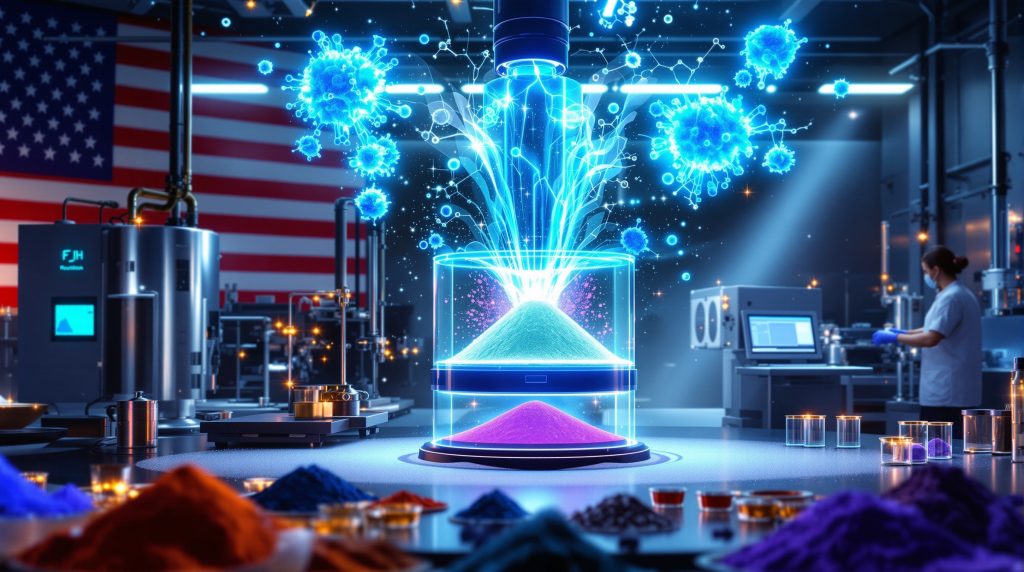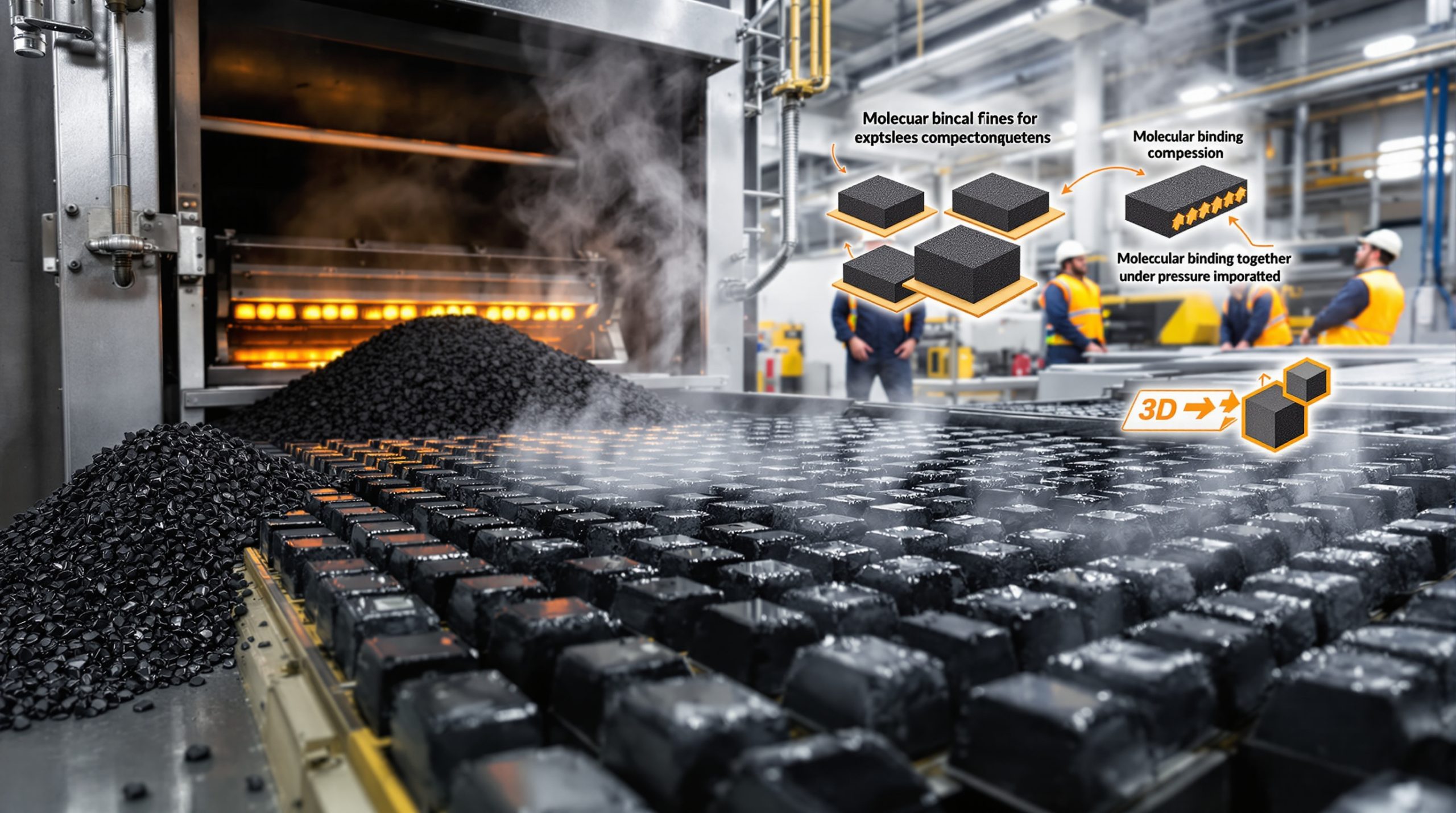What is Flash Joule Heating Technology and How is it Revolutionizing Rare Earth Processing?
Flash Joule Heating (FJH) represents a groundbreaking shift in rare earth element processing technology. This innovative approach utilizes rapid, high-voltage electrical pulses to generate extreme temperatures exceeding 3,000°C within target materials in mere milliseconds. Unlike conventional methods that require hours of processing with harsh chemicals, FJH creates instantaneous, localized heating that transforms the chemical structure of rare earth-bearing materials, making valuable elements more readily extractable.
The technology addresses a critical geopolitical challenge: China's dominance over approximately 85-90% of global rare earth refining capacity. According to the U.S. Geological Survey's 2024 Mineral Commodity Summaries, China produced approximately 240,000 metric tons of rare earth oxides in 2023, representing the vast majority of global supply. By establishing alternative processing capabilities, Western nations can reduce supply vulnerabilities for these critical minerals energy transition materials essential to renewable energy, defense systems, and advanced electronics manufacturing.
The rare earth crisis first gained global attention following China's 2010 export restrictions during a territorial dispute with Japan, which caused prices to spike by over 750% for some elements. This watershed event catalyzed Western nations to seek alternative supply chains and processing technologies like FJH.
The Fundamentals of Flash Joule Heating
At its core, FJH technology applies brief electrical pulses to generate intense, localized heating within milliseconds. This rapid thermal processing fundamentally changes how rare earth elements can be extracted from various feedstock materials. The process reaches temperatures exceeding 3,000°C almost instantaneously, creating unique reaction conditions impossible to achieve with conventional heating methods.
The extreme temperatures break chemical bonds and transform material structures in ways that conventional processing cannot match. This enables more efficient separation of valuable elements from surrounding matrices without the extensive chemical treatments traditionally required.
Breaking China's Rare Earth Monopoly
The U.S. Department of Energy's 2023 Critical Materials Assessment classifies rare earth elements among the most critical materials for green transition materials, with supply chain vulnerabilities rated as "high risk" due to concentration of processing in a single country. The U.S. Department of Defense has similarly identified rare earth processing as a critical capability gap in their 2023 Industrial Capabilities Report.
FJH technology offers a viable pathway to reduce dependence on Chinese processing infrastructure, which currently controls between 85-90% of global rare earth refining capacity. This concentration creates significant supply chain vulnerabilities for industries ranging from electric vehicles to defense systems.
Technical Advantages Over Traditional Methods
FJH processing delivers multiple measurable advantages compared to conventional rare earth refining methods:
- Processing time reduced from hours to seconds
- Energy consumption decreased by approximately 87%
- Greenhouse gas emissions cut by approximately 84%
- Operating costs lowered by roughly 54%
- Chemical reagent usage minimized significantly
- Waste generation reduced by approximately 90%
These performance metrics represent transformative improvements over traditional hydrometallurgical processes that typically require extensive use of acids, organic solvents, and multiple processing stages over 24-48 hours.
How Does Metallium's FJH Technology Work in Practice?
The practical application of FJH technology follows a systematic process designed to efficiently recover valuable rare earth elements from diverse feedstock materials. Each step has been optimized to maximize recovery rates while minimizing environmental impact and processing costs.
The Step-by-Step Process
-
Feedstock Preparation: Source materials (magnets, e-waste, mine concentrates) are first demagnetized at approximately 800°C to remove magnetic properties
-
Size Reduction: Materials are ground into fine powder to increase surface area and improve process efficiency
-
Flash Processing: The prepared powder is exposed to millisecond-duration electrical pulses in a controlled environment, reaching temperatures exceeding 3,000°C almost instantaneously
-
Chlorination Enhancement: When combined with chlorine gas (FJH-Cl₂), the process achieves superior separation of rare earth elements by creating volatile rare earth chlorides
-
Element Recovery: The processed material yields rare earth oxides or metals at over 90% purity and recovery rates, ready for downstream applications
This streamlined approach dramatically reduces the processing complexity compared to conventional methods that typically require multiple acid leaching steps, solvent extraction cycles, and precipitation processes over extended timeframes.
Material Versatility and Feedstock Flexibility
One of FJH technology's most significant advantages is its remarkable versatility across different material sources. The process effectively handles:
- NdFeB (Neodymium-Iron-Boron) and SmCo (Samarium-Cobalt) permanent magnets from end-of-life products
- Electronic waste containing critical minerals
- Mining concentrates and tailings
- Refinery scrap and byproducts
- Monazite and other REE-bearing minerals
This flexibility is particularly valuable given the diverse sources of rare earth elements. According to a 2023 study in Resources, Conservation and Recycling, approximately 50,000 tons of rare earth permanent magnets reach end-of-life annually from wind turbines, electric vehicles, and consumer electronics, representing a significant secondary resource opportunity.
What Makes Metallium's Technology Commercially Viable?
The transition from laboratory success to commercial implementation represents a critical challenge for any new technology. Metallium's FJH process offers several compelling advantages that support its commercial viability in the competitive rare earth processing landscape.
Economic Advantages
The FJH process delivers substantial economic benefits that enhance commercial feasibility:
-
Reduced Capital Requirements: Simplified processing flowsheets require less extensive infrastructure and equipment compared to conventional facilities
-
Lower Operating Expenses: Decreased energy, chemical, and labor inputs translate to operating cost reductions of approximately 54%
-
Higher Recovery Rates: Enhanced extraction efficiency exceeding 90% improves overall economics through better material utilization
-
Process Intensification: Compact equipment footprint reduces facility size requirements and associated real estate costs
-
Faster Processing: Dramatically shortened processing times from hours to seconds increase throughput potential and production capacity
Traditional rare earth processing facilities require significant capital investment, with typical Chinese processing plants costing $200-500 million for facilities processing 10,000+ tonnes annually. The streamlined FJH approach potentially reduces these capital requirements substantially.
Scaling Strategies and Commercial Implementation
Metallium is advancing from laboratory success to industrial-scale operations through a strategic development pathway:
| Development Phase | Scale | Timeline | Focus |
|---|---|---|---|
| Laboratory Validation | Grams | Completed | Proof of concept and process parameters |
| Pilot Testing | Kilograms | Completed | Process optimization and validation |
| Demonstration Plant | Tonnes | In progress | Commercial validation and product qualification |
| Commercial Facility | Thousands of tonnes | 2025-2026 | Full-scale production |
The company's Gator Point facility in Texas represents the culmination of this scaling strategy, with initial capacity of 8,000 tonnes per annum, expandable to 16,000+ tonnes annually. This phased approach allows for continuous optimization and risk management through the commercialization process.
Why Are Rare Earth Elements So Critical to Modern Technology?
Rare earth elements, despite their name, are relatively abundant in the Earth's crust. However, their dispersed distribution and complex extraction requirements have created significant supply chain challenges. Their unique properties make them essential components in numerous advanced technologies.
Strategic Applications Driving Demand
Rare earth elements serve as critical components in a wide range of high-technology applications:
-
Clean Energy: Wind turbine generators require approximately 600 kg of rare earth magnets per offshore turbine, while electric vehicles use 1-2 kg in their motor magnets
-
Electronics: Smartphones, computers, displays, and audio equipment rely on rare earths for miniaturization and performance
-
Defense Systems: The F-35 Joint Strike Fighter contains approximately 417 kg of rare earth materials across various systems, according to the U.S. Government Accountability Office
-
Medical Technology: MRI machines require approximately 170-270 kg of helium-cooled superconducting magnets containing significant amounts of neodymium
-
Advanced Manufacturing: Lasers, polishing compounds, and catalysts depend on specific rare earth elements for their unique properties
According to the International Energy Agency's 2024 Global EV Outlook, electric vehicle production reached 13.6 million units in 2023, creating substantial demand for rare earth magnets in motor systems. This demand is expected to accelerate as clean energy technologies continue to expand globally.
The Most Valuable Rare Earth Elements
While the rare earth group includes 17 elements, certain members hold particularly high strategic and economic value:
-
Neodymium (Nd): Essential for producing the strongest permanent magnets commercially available (NdFeB), priced at approximately $65-75/kg as of Q3 2024
-
Dysprosium (Dy): Enhances magnet performance at high temperatures, critical for EV motors, priced at approximately $350-400/kg
-
Terbium (Tb): Critical for magnets and phosphors in displays and lighting, commanding premium prices of approximately $1,200-1,400/kg
-
Praseodymium (Pr): Used in magnets and specialized glass applications as a neodymium substitute or complement
-
Samarium (Sm): Component in specialized magnets for high-temperature applications and nuclear technologies
The price disparity between different rare earth elements highlights the importance of selective recovery and separation technologies that can target the most valuable components from mixed material streams.
How Does Rice University's Research Support Metallium's Technology?
The partnership between academic research and commercial application plays a crucial role in advancing new technologies from concept to market. Rice University's collaboration with Metallium exemplifies this technology transfer process.
Collaborative Research Framework
The partnership between Rice University and Metallium demonstrates effective technology transfer from academic research to commercial application. The university's materials science expertise provides:
- Fundamental scientific validation through peer-reviewed research
- Process optimization through systematic experimentation
- Technical credibility through independent verification
- Ongoing innovation to expand technology capabilities
According to the Association of University Technology Managers, successful technology commercialization typically requires 5-7 years from initial research to market deployment. The Rice University-Metallium collaboration accelerates this timeline through focused development efforts.
Key Research Findings
Recent peer-reviewed studies from Rice University, led by Professor James Tour's research group, have demonstrated:
- Over 90% recovery of rare earth elements from waste magnets
- Complete processing in seconds rather than hours
- Significant reductions in environmental impact metrics
- Potential for "flash-within-flash" processing for advanced material synthesis
- Applicability across diverse feedstock types
The Rice University team first published on Flash Joule Heating technology in 2020 in Nature Communications, demonstrating the technique for converting carbon sources to graphene. The research has since expanded to encompass rare earth recovery, battery material synthesis, waste plastic upcycling, and concrete additive production.
What Environmental Benefits Does FJH Technology Offer?
Environmental considerations have become increasingly important in materials processing, particularly for technologies supporting clean energy transitions. FJH technology offers substantial environmental advantages compared to conventional rare earth processing methods.
Sustainability Advantages
The environmental profile of FJH technology represents a marked improvement over conventional rare earth processing:
-
Reduced Chemical Usage: Minimizes or eliminates acids and other hazardous reagents that typically include hydrochloric acid, sulfuric acid, and organic solvents
-
Lower Energy Intensity: Requires approximately 87% less energy per unit of production compared to conventional methods
-
Decreased Water Consumption: Reduces process water requirements significantly compared to traditional hydrometallurgical approaches that use 1,000-2,000 cubic meters of water per ton of concentrate processed
-
Minimal Waste Generation: Produces approximately 90% less solid and liquid waste than conventional methods
-
Smaller Land Footprint: Requires less physical space for processing facilities due to process intensification
-
Circular Economy Support: Enables effective recycling of rare earth materials from end-of-life products
These environmental benefits directly address concerns associated with traditional rare earth processing. The U.S. Environmental Protection Agency notes that conventional methods generate approximately 2,000 tons of toxic waste for every ton of rare earth oxide produced.
Greenhouse Gas Reduction Potential
Life cycle assessments indicate FJH technology can reduce greenhouse gas emissions by approximately 84% compared to conventional processing methods. This significant reduction supports decarbonization goals across the supply chain, particularly important for clean energy technologies that rely on rare earth elements.
The Baotou region in Inner Mongolia, China's largest rare earth processing hub, has been documented with significant environmental contamination including a large tailings dam containing radioactive and toxic waste from decades of processing. FJH technology offers an alternative approach that substantially reduces such environmental impacts.
How Will Metallium's Gator Point Facility Transform U.S. Rare Earth Supply?
The development of domestic rare earth processing capacity represents a strategic priority for the United States and other Western nations seeking to reduce dependence on Chinese supply chains. Metallium's Gator Point facility aims to address this critical gap.
Strategic Facility Development
Metallium's Gator Point Technology Campus represents a significant step toward domestic rare earth processing capability:
-
Location: Strategic Texas location with excellent logistics infrastructure and proximity to electronics recycling centers
-
Initial Capacity: Approximately 8,000 tonnes per annum of e-waste feedstock, providing a significant contribution to domestic processing capacity
-
Expansion Plans: Scalable design to reach 16,000+ tonnes annually as operations mature and market demand increases
-
Commissioning Timeline: Targeted for December 2025, aligning with growing market demand for domestic rare earth processing
-
Product Focus: Critical minerals and precious metals recovery, with particular emphasis on high-value rare earth elements
The United States currently has minimal domestic rare earth processing capacity outside of MP Materials' Mountain Pass facility in California, which processes approximately 38,000-40,000 metric tons of rare earth concentrate annually but sends most material to China for separation and refining.
Supply Chain Implications
The facility's development addresses several critical supply chain vulnerabilities:
- Reduces dependence on Chinese processing infrastructure
- Shortens supply chains for U.S. manufacturers
- Increases supply security for defense applications
- Creates domestic capacity for recycling critical materials
- Establishes technical expertise within the U.S. industrial base
The U.S. Department of Defense's Defense Production Act Title III program has invested over $500 million since 2019 in rare earth and critical minerals reserve projects aimed at reducing supply chain dependence. Facilities like Gator Point align with these strategic priorities by creating domestic processing capabilities.
What Strategic Partnerships Are Advancing FJH Technology?
Successful commercialization of new processing technologies typically requires strategic partnerships across the value chain. Metallium has established several key collaborations to accelerate development and deployment of FJH technology.
Key Industry Collaborations
Metallium has established strategic partnerships to accelerate technology deployment:
-
Ucore Rare Metals: Integration with RapidSX™ separation technology, a molecular recognition technology for rare earth separation that can process rare earths faster and with lower environmental impact than traditional solvent extraction
-
Rice University: Ongoing research and development collaboration, providing scientific validation and continuous innovation
-
Government Agencies: Support through strategic minerals initiatives focused on domestic supply chain development
-
End-Users: Product qualification and offtake arrangements with manufacturers requiring rare earth materials
These partnerships create an ecosystem supporting the full value chain from technology development through commercial implementation.
Integration with Complementary Technologies
The FJH process works synergistically with other advanced separation and processing technologies:
- Solvent extraction systems for final purification
- Ion exchange technologies for specific element separation
- Electrochemical reduction for metal production
- Advanced sensing and process control systems
This integration capability allows for the creation of complete processing flowsheets that can take mixed rare earth materials from initial treatment through to separated high-purity oxides and metals ready for manufacturing applications.
What Are the Investment Implications for the Rare Earth Sector?
The development and commercialization of FJH technology could significantly impact investment dynamics in the rare earth sector, creating new opportunities while potentially disrupting existing business models.
Market Transformation Potential
The commercial deployment of FJH technology could reshape rare earth markets in several ways:
- Diversification of supply chains beyond Chinese dominance
- Potential cost structure improvements across the industry
- Increased viability of recycling and secondary recovery
- Enhanced environmental performance meeting ESG requirements
- New opportunities in domestic processing infrastructure
According to Allied Market Research, the global rare earth market is expected to reach $15.3 billion by 2030, growing at a CAGR of 9.3%. This growth trajectory creates significant opportunities for new processing technologies that can address existing supply chain constraints.
Future Growth Trajectories
As the technology matures, several growth pathways emerge:
- Expansion to additional critical minerals beyond rare earths
- Integration into existing mining operations
- Application to historical waste streams and tailings
- Development of specialized processing services
- Licensing opportunities for global deployment
The permanent magnet market, a primary end-use for rare earth elements, is projected to grow from $22.5 billion in 2023 to $38.7 billion by 2030 according to Grand View Research. This end-market growth drives demand for more efficient and environmentally sustainable processing technologies.
What Challenges Must Be Overcome for Widespread Adoption?
Despite its promising advantages, FJH technology faces several technical, commercial, and competitive challenges that must be addressed for successful widespread adoption in the rare earth processing sector.
Technical and Commercial Hurdles
Several challenges remain in the path to full commercial implementation:
-
Scale-Up Complexity: Translating laboratory success to industrial scale often encounters unexpected engineering challenges
-
Product Certification: Meeting stringent end-user specifications for high-purity rare earth products requires rigorous quality control
-
Process Optimization: Maximizing recovery across diverse feedstocks with varying compositions demands sophisticated process control
-
Capital Requirements: Securing funding for commercial facilities represents a significant hurdle for new technology deployment
-
Market Development: Establishing customer relationships and offtake agreements requires demonstrated product quality and reliability
The transition from processing kilograms to thousands of tonnes annually involves substantial engineering and operational challenges that must be systematically addressed.
Competitive Landscape
FJH technology must compete with both established and emerging processing approaches:
- Conventional solvent extraction and separation methods with decades of operational history
- Alternative novel technologies under development by other companies and research institutions
- Existing Chinese processing infrastructure with established economies of scale
- Integrated mining and processing operations with secure feedstock supplies
Overcoming these competitive challenges requires clear demonstration of FJH technology's economic and environmental advantages at commercial scale.
FAQs About Metallium's Rare Earth Refining Technology
What makes Flash Joule Heating different from conventional rare earth processing?
FJH uses rapid electrical pulses to generate extreme temperatures within seconds, dramatically reducing processing time, energy consumption, and chemical usage compared to traditional acid leaching and solvent extraction methods that typically require hours or days of processing with hazardous chemicals. The technology achieves temperatures exceeding 3,000°C almost instantaneously, creating unique reaction conditions impossible with conventional heating.
Can FJH technology process all types of rare earth-bearing materials?
Yes, the technology has demonstrated effectiveness across diverse feedstocks including end-of-life magnets, electronic waste, mining concentrates, and various mineral sources. The process parameters can be optimized for different material compositions, making it highly versatile across the rare earth supply chain. This flexibility is particularly valuable given the diverse sources of rare earth elements in both primary mining and secondary recycling streams.
How does FJH technology impact the economics of rare earth recycling?
By reducing operating costs by approximately 54% while achieving over 90% recovery rates, FJH significantly improves the economic viability of recycling rare earth materials from waste streams that were previously uneconomical to process. This cost advantage makes urban mining of rare earths from end-of-life products increasingly attractive as a supplement to primary mining sources. The European Union's Circular Economy Action Plan identifies rare earth recycling as a priority, with targets to increase recycling rates from current levels of less than 1% to 15% by 2030.
What timeline is expected for full commercial deployment?
Metallium is targeting commissioning of its first commercial-scale facility by December 2025, with initial processing capacity of approximately 8,000 tonnes per annum, expandable to 16,000+ tonnes as operations mature. This timeline represents an accelerated development pathway compared to typical technology commercialization timeframes, reflecting both the strategic importance of rare earth processing and the maturity of the underlying technology.
How does this technology address supply chain security concerns?
By establishing domestic processing capability outside of China, FJH technology helps diversify global rare earth supply chains, reducing geopolitical vulnerabilities for critical materials essential to defense, clean energy, and high-technology manufacturing. The U.S. Geological Survey classifies rare earth elements as "critical minerals" essential to economic and national security, noting that "the United States is 100% import-reliant for 14 critical minerals, including rare earth elements." FJH technology provides a pathway to reduce this import dependence through domestic processing capabilities.
Further Exploration
Readers interested in learning more about advancements in rare earth processing technologies can explore related educational content at Stocks Down Under for additional market analysis and technology updates.
The global rare earth elements market is projected to grow significantly, reaching approximately $15.3 billion by 2030 according to recent market research. As demand continues to increase for these critical materials in clean energy, advanced electronics, and defense applications, technologies like Flash Joule Heating will play an increasingly important role in creating sustainable and secure supply chains.
Furthermore, industry experts anticipate that emerging technologies like Metallium's rare earth refining technology will be showcased at the upcoming global mining innovation expo, which highlights cutting-edge solutions in resource extraction and processing. Additionally, the mining sector is increasingly embracing data-driven mining operations to optimize processes like Metallium's FJH technology, ensuring maximum efficiency and sustainability in rare earth element recovery.
Curious About Tracking the Next Major Mineral Discovery?
Gain a market-leading edge with Discovery Alert's proprietary Discovery IQ model, which instantly notifies investors of significant ASX mineral discoveries, turning complex data into actionable insights. Begin your 30-day free trial today and understand why major discoveries generate substantial returns by visiting the dedicated discoveries page.




